indian discoveries and inventions – Part II : WE CLAIM THESE ARE INDIAN DISCOVERIES
PROGRESSION OF THE TYPE 12 + 22 + 32 + 42 + ….
Sapthaanaam ashtaanaam saptadasaanaam chathurbhu jaaschithaya: ekavidyaanaam vaachyam padastharaasthaa hi vargaakhyaa:
There are (three pyramidal) piles on square bases having 7, 8 and 17 layers which are also squares. Say the number of units there in.
BHASKARACHARYA I – ARYABHATEEYA BHASHYA 628 AD
PROGRESSION OF THE TYPE 13 + 23 + 33 + 43 +
Chathurasraghanaschithaya: panchachathurnavastharaa vinirdesyaa: ekaavaghatithaasthaa: samachathura sreshtakaa: kramasa:
There are three pyramidal piles having 5, 4 and 9 cuboidal layers. They are cuboidal bricks (of unit dimension) with one brick in the topmost layer. Find the number of bricks used in them.
BHASKARACHARYA I – ARYABHATEEYA BHASHYA 628 AD
PROGRESSION OF THE TYPE _n + _n2 + _n3 + _n 4
Sankalithakruthighanaanaam sankalithasamaasamaanaam me kathaya shannaam sakhe padaanaam ganayithvaa yadivijaanaasi
Friend, if you know, then say after calculation (i) the sum of successive sum of 6 natural numbers (ii) the sum of the squares of the first 6 natural numbers and (iii) the sum of the cubes of first 6 natural numbers.
SREEDHARACHARYA – IN PATIGANITHA 900 AD
FIRST DEGREE INDETERMINATE EQUATION
Mudgaanaam kudavaa: saptha labhyanthe navabhi: pane: panena kudavasyaardham thandulaanaamavaapyathe thatha: panathrayam saardham gruheethvaa_asu vaningmama thandulaanaam prayacchaamsa mudgaanaam cha dvisangunam
7 kudavas (unit of measurement) of mudga are obtained for 9 panas and ½ kudava of rice is obtained for one pana. Then O! merchant take 3½ panas and quickly give me one part of rice and two parts of mudga.
SREEDHARACHARYA – IN PATIGANITHA 900 AD
FIRST ORDER EQUATION – I
Ye nirjaraa dinadinaardha thrutheeya shashtai: sampoorayanthi pruthak pruthakeva mukthaa: vaapeem yadaa yugapadeva sakhe vimukthaasthe kenavaasaralavena thadaa vadaasu
By opening 4 inlets separately, one pond gets filled respectively within 1, ½, 1/3, and 1/6 days. If all the four inlets are opened together, how much time (in fraction of the day) is required to fill the pond ?
BHASKARACHARYA II – IN LILVATI 1114 AD
FIRST ORDER EQUATION – II
Nava gulikaa saptha (cha) roopakasamaasthrayaanaam (thu) gulikaanaam thrayodasaanaam cha roopakaanaam thadaa kim gulikaa moolyam
If 9 gulika and 7 rupaka are equal to 3 gulika and 13 rupaka, what is the price of one gulika? (the answer can be determined through the same method followed above)
SREEDHARACHARYA PATIGANITHA 990 AD
EQUATIONS OF HIGHER ORDER- I
Vaanarakulathribhaga: svathryamsa samanvi1tha: sara: prayayow moolam cha pipaasathi dvow choothathale sthithow seshow
One third of a troop of monkey with one third of itself has gone to the tank; the square root of the whole troop is afflicted with thirst, and the remaining 2 monkeys are sitting under the mango tree. What is the total number of monkeys? 1/3 a + 1/9 a + _a + 2 = a.
REEDHARACHARYA – PATIGANITHA 990 AD
EQUATIONS OF HIGHER ORDER- II
Bale maralakula mooladalaani saptha theere vilaasabhara manthara gaanyapasyam kurvancha keleekalaham kalahamsayugmam sesham jale vada maraalakula pramaanam
I saw that one half of 7 times of the square root of the total number of swans were slowly moving away in the river. Remaining 2 are playing in water. What is the number of total swans? (equation: 7/2 _a+2=a)
BHASKARACHARYA – LILAVATI 1114 AD
PYTHAGORUS THEOREM DISCOVERED BY BOUDHAYANA
Samachathurasrasyakshnayaa rajju dvishtavathim bhoomim karothi
The diagonal of a square produces double the area of the square.
Deerghachathurasrasyakshnayaarajju: paarsvamaani thiryanmaani cha yatpruthakbhoothe kuruthasthadubhayam karoti
Areas produced separately by the length and breadth of rectangle together equal to the area of the (square) produced by the diagonal.
BOUDHAYANA BOUDHAYANA SULBASUTRA 700 BC
EXPLANATION OF BINOMIAL THEOREM
If a three syllablic Madhya Chanda based on guru and lakhu sounds were followed, then variation of guru and lakhu sound will be on the following pattern:
3 guru sound occur once, 2 guru and 1 lakhu occur thrice, 1 guru and 2 lakhu sounds occur thrice, 3 lakhu occur once. The equation can be derived easily. If guru is g and lakhu is 1 then,
(g+1)3 = g3+3g21+3g12+l3.
This equation is the same as (x+y)3. Similarly for finding the pratishta Chanda, in the Chanda sastra of Pingalacharya, the following equation can be indirectly applied in this form: (g+1)4 which is expanded as
g4+4g31+4g212+4g13+14
I.e 4 guru sound occur once, 3 guru and 1 lakhu occur four times, 2 guru and 2 lakhu occur four times, 1 guru and 3 lakhu occur four times and 4 lakhu occur once.
PINGALACHARYA – CHANDASASTRA 200 BC
GEOMETRY IN SULBASUTRA-II
Thaasaam trika chathushkayordvaadasikapanchikayo: panchadasikaashti kayo: saaptikachathurimsathikayo: dvaadasika panchathrimsathikayo: panchadasikashad- thrimsikayo: ithyethaasoopalabdhi:
Hypotenuse in rectangles having sides 3 and 4 (= 5), 12 and 5 (= 13), 15 and 8 (= 17), 7 and 24 (= 25), 12 and 35 (= 37) and 15 and 36 (= 39) (I.49).
BOUDHAYANA BOUDHAYANA SULBASUTRA 700 BC
ANGULAR DIMENSIONS
Angagunavedahuthaasaa: kalikaa vikalaa: samudrajaladhaya: svalpajalakhaashtasasi dhruthisasina: kalikaa: saraagnayo vikalaa: thrijyaakruthivarashta navathribhuvo visve jinaamsajyaa.
Thribhujasya phalasareeram samadalakoti bhujaardha samvarga:
The area of a triangle is the product of the prependicular and half the base.
ARYABHATTA I ARYABHATEEYA 499 AD
Karnasthrayodasa syaath panchadasaanyo mahee drisapthaiva vishamasthri bhujasya sakhe phalasankhyaa kaa bhavedasya
What is the area of a scalene traingle in which one lateral side is 13 units, other 15 unit and the base is 14 units.
Ashtaadasakocchrayovamso vaathena paathithomoolaath shadgathvaavasow pathithaasthribhujam kruthvaa kva bhaghna: syaath
A bamboo of beight 18 cubits fell by the wind, it falls at a distance of 6 cubits from the root, thus forming a right triangle, where is the break?
BHASKARA I COMMENTARY TO ARYABHATEEYA 628 AD




